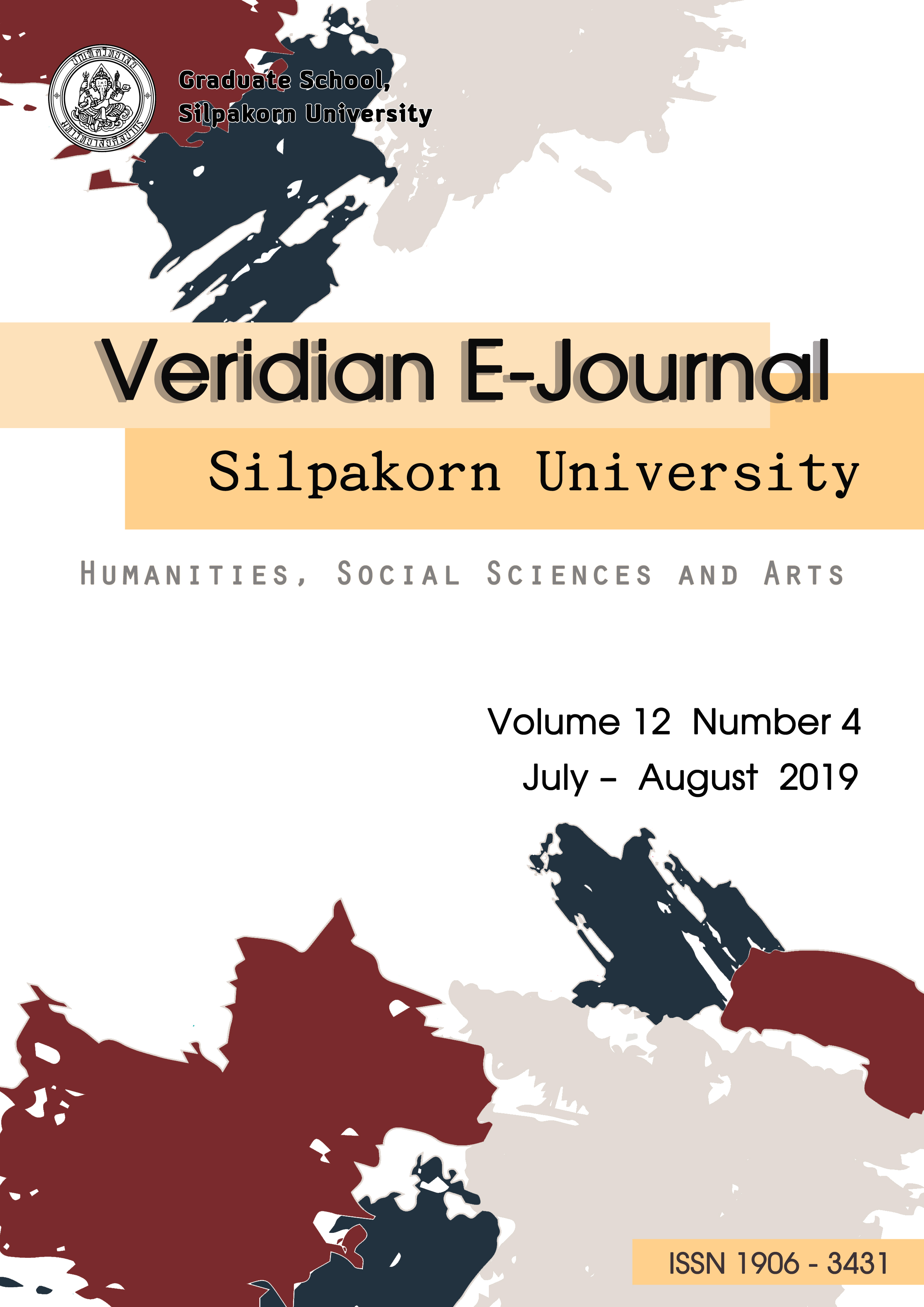ศิลปิน : การผันแปรแนวคิดทัศนศิลป์ จากลัทธิประทับใจสู่ศิลปะหลังสมัยใหม่ (Changing of Visual Art Concept from Impressionism to Post-Modernism)
Main Article Content
Abstract
บทความนี้เป็นการศึกษา ค้นคว้า จากหนังสือ ตำรา เอกสาร ว่าด้วยเรื่องการผันแปรทัศนะแนวคิดของศิลปินผสานกับแนวคิดของนักปรัชญาที่มีต่อการรังสรรค์ผลงานด้านทัศนศิลป์ โดยเริ่มจากปลายคริสต์ศตวรรษที่ 19 ศิลปินลัทธิประทับใจ อันเป็นตัวแทนของชนชั้นกลางที่ขบถต่อทัศนศิลป์หรือสุนทรียะของชนชั้นสูง ที่เรียกตัวเองว่าผู้มีวัฒนธรรม แต่บทบาทสำคัญที่ทรงอิทธิพลต่อการเปลี่ยนแปลงครั้งนั้น คือ ลัทธิประทับใจยุคหลัง เริ่มด้วยผลงานของ ปอล เซซาน บิดาแห่งศิลปะสมัยใหม่ ต่อมาต้นคริสต์ศตวรรษที่ 20 ได้พัฒนามาเป็นศิลปะ บาศกนิยมที่เน้นเส้น ระนาบและรูปทรงที่แปลกพิกล บิดเบี้ยวไม่เหมือนจริง ได้ตอกย้ำความอิสระของมนุษย์ที่จะเลือกดูความจริงจากมุมไหนก็ได้ สนใจการแสวงหาตัวตน อัตลักษณ์ ทั้งปัจเจกบุคคลและกลุ่มเพื่อค้นหาคำตอบใหม่ ท้าทายอำนาจความคิดเดิมอย่างตรงกันข้ามและเป็นแรงบันดาลใจให้แก่ศิลปินในยุคต่อมา แนวคิดด้านปรัชญาต้นคริสต์ศตวรรษที่ 19 ปรัชญา “ศิลปะเพื่อศิลปะ” ได้มีบทบาทต่อศิลปินและ นักปรัชญาต่างเห็นว่า ศิลปะมีคุณค่าด้วยตัวของมันเอง บริสุทธิ์ ไม่ใช่สร้างขึ้นเพื่อรับใช้สังคม ความเชื่อ ความศรัทธาในศาสนา พระมหากษัตริย์ดังเช่นในอดีต ปลายคริสต์ศตวรรษที่ 19 เกิดทฤษฎีศิลปะ คือ ทฤษฎีอารมณ์นิยม ทัศนะปรัชญานี้เห็นว่า อารมณ์ในตัวมนุษย์มีความสำคัญ แก่นแท้ของศิลปะ คือ การแสดงออกซึ่งอารมณ์ความรู้สึกของศิลปินให้ปรากฏในงานศิลปะ ต่อมาต้นคริสต์ศตวรรษที่ 20 เกิดแนวคิดศิลปะสมัยใหม่ ปรัชญา “ทฤษฎีรูปทรงนิยม” ได้เข้ามีบทบาทเพื่อหักล้างทฤษฎีการลอกเลียนแบบ โดยเห็นว่ารากของศิลปะ คือ รูปทรงนัยหรือรูปทรงบริสุทธิ์ ซึ่งส่งผลต่องานศิลปะสมัยใหม่ คือ ศิลปะนามธรรม อันเป็นสัญลักษณ์ของศิลปะสมัยใหม่อย่างแท้จริง แนวคิดศิลปะหลังสมัยใหม่ ได้ถูกนำมาใช้กลางคริสต์ศตวรรษที่ 20 ประมาณปี ค.ศ. 1950 เป็นการ
อ้างถึงกระบวนแบบใหม่ของสถาปัตยกรรมปฏิเสธแนวสมัยใหม่ แนวคิดที่เข้ามามีบทบาทต่อศิลปะ คือ แนวคิดสรรผสาน แนวคิดรื้อโครงสร้าง ผลงานศิลปะหลังสมัยใหม่ที่เน้นการรังสรรค์ว่ามีคุณค่า กลับมานิยมการเลียนแบบ ไม่สนใจอัตลักษณ์หรือลักษณะเฉพาะตน ผลงานจึงผสมผสาน ปนเป นิยมการหยิบยืมจากแหล่งต่าง ๆมาสร้างผลงาน นิยมความยุ่งเหยิง ขัดแย้ง ไม่ชัดเจน และเห็นว่างานศิลปะไม่จำเป็นต้องอยู่ในพิพิธภัณฑ์ เชื่อเรื่องโลกไร้พรหมแดนเป็นวัฒนธรรมโลก นักปรัชญาที่มีบทบาทสำคัญ คือ ฟรีดริช วิลเฮล์ม นิทเช่ ชาวเยอรมัน ปรัชญาที่สำคัญ คือ “เจตจำนงที่จะมีอำนาจ” นิทเช่มองว่ามนุษย์เป็นผู้กำหนดความจริงให้กับโลกภายนอกและมองว่า ศิลปะเป็นการสร้างสรรค์ของมนุษย์มากกว่าการถ่ายทอดจากธรรมชาติ ศตวรรษดังกล่าวยังมีนักคิด นักปรัชญาอีกหลายท่าน เช่น โรลองค์ บาร์ตส์ นักคิดชาวฝรั่งเศส เจ้าของผลงาน สัญวิทยา ฌาคส์ แดริดา ผลงานที่โดดเด่น คือ “การรื้อสร้าง” นอกจากนี้ยังมี มิเชล ฟูโก้, ลีโอตาร์ และคนอื่น ๆ
The article is a learning and researching from textbooks and documents about the Conceptual variance of artists merged with philosophers for creating visual art works. Starting from the end of the 19th century. Impressionism artists is a representative of the middle class that revolt to visual arts or aesthetic of the aristocracy who called themselves “ The civilized people “. However, the important role that influence for changed is Post-Impressionism. Begin with the work of Paul Cézanne. ; The father of us all. Later,early 20th century it is developed into “Cubism” ; Focus on the strange line flat and shape. Distorted and unreal. It emphasises the independence of human that can choose the truth from anyway. Interested in acquiring identity both individuals and groups search for new knowledge. Challenging the power of the original idea in the opposite direction and to be inspiration for artists in later time.
Philosophy idea in early 19th century. Philosophy “Art for art” has a role for artist. Philosophers see that the art has its own value. It’s pure. It’s built for giving service to society, believe and faith in religion and king as in the past. The end of 19th century, It begins Theory of art that is an Emotionalism Theory. The outlook of philosophy see that the emotional in a human is important. The essence of art is a expression of artist to appear in art work. Then, early 20th century. It begins the modern art. Philosophy “Formalism Theory” comes to play a role for refuting the imitationalism Theory. By seeing that the original or root of art is a pure form which affects to Modern art. It’s an abstract art which is truly symbol of Modern Art. The idea after Modern Art is applied in the middle of 20th century (around 1950 A.D ) as a claim to new process of the architecture that refuse Modernism. The idea that plays a role to art is Eclecticism and Deconstruction. The art work after modern art that focus on creating value art and be back to admire to imitate ,don’t care about identity. So, the art work is mixed. Admire to borrow the others work from anywhere to make work’s art. The popular is disorder,conflict ,unclear and see that art work doesn’t have to be in museum. Believe about Globalisation is a world ‘s culture. The important philosopher is Friedrich Wilhelm Nietzsche, German. The important philosophy is The Will – to – Power. He sees the human determine the truth to the outside world and think that art is created by the human more than a Natural transmission. This century has many other philosophers. For example, Roland Barthes (French) who is the owner of “Semiology”, Jacques Derrida. His outstanding work is “Deconstruction” There is also Michel Foucault, Lyotard and others

